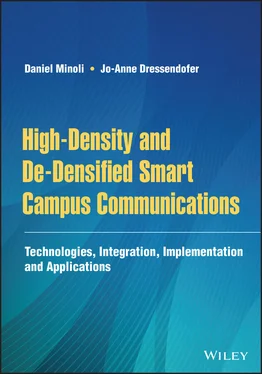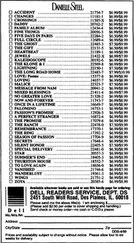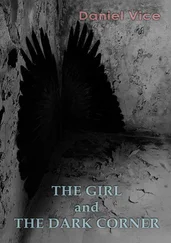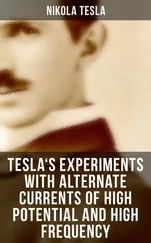High‐density campus communications play a role in the evolution of Smart Campuses but also drive the Smart City and Smart Building use cases. Connectivity is now considered a fourth utility (in addition to gas, water, and electricity). In fact, massive‐type communication is a recognized requirement of 5G, even if just in the machine‐type communication environment. In the campus applications just cited, people‐to‐people, people‐to‐websites, and people‐to‐applications connectivity is increasingly important, given that nearly everyone now carries a smartphone and many apps entail high‐throughput transmissions.
There are unique requirements and unique designs required for high‐density communications, particularly because of the relative scarcity of available spectrum. In addition, there has been and continues to be a set of transitions, even transformations, of the underlying technologies. The world has moved to IP for all data, voice, and video communications. Additionally, there is a trend toward the use of Wi‐Fi‐based hotspot communication in all practical situations, due to near ubiquity of service, lower end‐user costs, higher bandwidth, technical simplicity, lower infrastructure costs, decentralized administration, regulation relief, and non‐bureaucratic delivery of service (without the reliance of large institutional providers). While 5G promises to deliver a set of new capabilities, neither 3G nor 4G displaced Wi‐Fi as a common access technology in the office, in the campus, on the street, and in travel. The technologies per se used for high‐density communications are not new (perhaps with the exception of 5G), but the requirements, as well as the design and system synthesis, are relatively unique.
As the second decade of the twenty‐first century rolled along, however, a new requirement presented itself due to the worldwide pandemic: physical/desk distancing in support of Office Social Distancing (OSD) and Office Dynamic Cluster Monitoring and Analysis (ODCMA). Wireless technologies have been harvested to address and manage these pressing issues. Real‐Time Locating Systems (RTLS) have been employed for a number of years to automatically identify and then track the location of objects or people in real‐time, within a building, or in other constrained locations are seeing renewed interest and applications. Even if effective vaccines are found and distributed globally, the common opinion is that many (but not all) societal and workplace changes driven by the pandemic may become permanent.
This book assesses the requirements, technologies, designs, solutions, and trends associated with High‐Density Communications (HDC). We believe this to be the first book that specifically synthesizes the topic of applied high‐density communications. Chapter 1looks at the functional requirements for high‐density communications. Chapter 2discusses the traditional data/Wi‐Fi Internet access, including OTT video. Chapter 3addresses the traditional voice/cellular design for campus applications, especially the Distributed Antenna System (DAS). Chapter 4peruses the traditional sensor networks/IoT services approaches. Chapter 5is the core of this text and examines evolved Wi‐Fi hotspot connectivity and related technologies (Wi‐Fi 5, Wi‐Fi 6, spectrum, IoT, VoWiFi, DASs, microcells issues, 5G versus Wi‐Fi issues), as well as intelligent integration of the discrete set of campus/venue networks into a cohesive platform usable in airports, stadiums, convention centers, classrooms, hospitals, and the like.
Chapter 6starts the discussion on de‐densification, using the same kind of technologies discussed in part one of the book; it considers the topic of office social distancing and discusses one of the available technologies. Chapter 7covers the use of Ultra‐Wideband (UWB) technologies. Chapter 8addresses the office social distancing challenge using Wi‐Fi, Bluetooth, and cellular/smartphone methodologies. Chapter 9provides a use case for HDC systems, and Chapter 10offers a pragmatic view for some of the economics of broad deployment of HDC.
The book is targeted to networking professionals, technology planners, campus administrators, service providers, equipment vendors, and educators. It is not a research monograph, but rather it aims at integrating the real‐world deployment of technologies, strategies, and implementation issues related to delivering an actual working HDC environment in any of the key venues listed above. It is important to note that the composition of this book started in February 2020. While social distancing in the office and public venues was a crucial short‐term goal at press time, the business‐ and public‐venue density requirements will likely resurge over time, likely with some yet to be foreseen modifications.
Many books delve extensively on general technologies of all types; however, they fall short in terms of the economics of such technologies, deployment challenges, associated security issues, and most lack tangible case studies. This book addresses these key aspects, based on actual deployment by the team associated with this writing, at a top US airport.
Some portions of this text make use of patent material filed with the United States Patent Office. All inventors cited are implicitly acknowledged for their contribution to this synthesis.
Daniel Minoli
DVI Communications
Jo‐Anne Dressendofer
Slice Wireless Solutions
30 December 2020
DANIEL MINOLI
Mr. Minoli is the principal consultant at DVI Communications. He has published 60 technical telecom and IT books, many are the first in their field (e.g., the first‐ever book on VoIP, the first‐ever on outsourcing of telecom services, the first‐ever book on metro Ethernet, the first‐ever book on green networks, the first‐ever book on IPv6 security, the first book on public hotspots, and the first book on IPv6 support of IoT, among others); he has also published 340 other papers (the majority of which are peer‐reviewed). Many books focus on raw technologies and fail to address Return on Investment (ROI), deployment, security considerations, and to provide case studies; Mr. Minoli's books aim to address these key issues when documenting the applicability of the underlying technologies.
Mr. Minoli started to work on wireless LANs in the late 1970s as part of ARPANet‐sponsored R&D and continued wireless work in the form of Geo/Meo satellite transmission, microwave, free space optics, mmWaves/“wireless fiber,” cellular, Wi‐Fi WLANs, sensor networks, wireless IoT, crowdsensing, 900 MHz SCADA, BMSs, UltraWideband, and 5G. He has written two books on LANs and several long book chapters on WLANs in other books; and, as noted, he has written a book on public hotspots and a book on metroEthernet/VPLS. At press time, over 225 published US patents, as well as 38 US patent applications, cite his work. Additionally, 5917 academic researchers cite his work in their own publications, according to Google Scholar, including 1887 citations of his books on Wireless Sensor Networks, 569 of his books/papers on IoT, 344 of his books on enterprise architectures, 262 of his books on video, and 259 of his books on VoIP. Mr. Minoli is a reviewer for several publishers, including Elsevier, Springer, IEEE, and Wiley. He has taught (adjunct) over 75 college graduate/undergraduate courses at New York University, Stevens Institute of Technology, and Rutgers University. He has been affiliated with Nokia, Ericsson, AT&T, SES, Prudential Securities, Capital One Financial, and AIG, and has been an expert witness/testifying expert in about 20 patent lawsuits. He has undertaken Intellectual Property (IP) work related to patent invalidity, infringement/non‐infringement analysis, breach‐of‐contract, dispute of equipment functionality, and IP portfolio valuation in the area of packet video/IPTV, packet voice/VoIP, networking, imaging (scanned checks), IoT, and wireless. He has provided Court testimony, sustained numerous depositions, and produced numerous Expert Reports, Rebuttal Reports, and Post Grant Review Declarations.
Читать дальше












